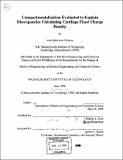Compartmentalization evaluated to explain discrepancies calculating cartilage fixed charge density
Author(s)
Thomas, Arun Mammen, 1974-
DownloadFull printable version (5.389Mb)
Advisor
Martha L. Gray.
Terms of use
Metadata
Show full item recordAbstract
Recent studies on methods of detecting the early onset of arthritic cartilage degradation using NMR-based techniques have shown that such detection is possible. The use of sodium NMR observations, along with an ideal Donnan single compartment model of cartilage, has already been validated as a means of measuring cartilage fixed charge density - a known indicator of cartilage condition. Similar calculations of fixed charge density from proton (in the presence of gadopentetate) NMR observations and the same model were highly correlated with, but 50% below, values derived from sodium NMR. Maroudas had previously shown the water content of cartilage to be divided with a roughly 30:70 ratio between two physiologically distinct regions. The first of these regions, within cartilage collagen fibrils, is electroneutral, with most of the tissue fixed charge, in the form of chondroitin sulfate, being concentrated in the remainder of the tissue, the second region. The existence of two compartments, with different associated fixed charge densities, is shown, by spreadsheet computations and analysis of previously published data, to be a possible reason for the observed 50% discrepancy. High-concentration chondroitin sulfate solutions within dialysis tubing bags were equilibrated in solutions containing sodium and gadopentetate ions. This solution/tubing apparatus mimicked an ideal Donnan single compartment. MR measurements of the amounts of the two ions and calculations of fixed charge density in the solutions based on the measurements yielded the same 50% factor. Since this artificial model did not include any collagen, there were no compartmentalization effects due to structural factors. A similar single-compartment was done using a non-ionic contrast agent to test for steric exclusion based compartmentalization. Although MR measurements revealed a discrepancy in contrast agent distribution, the discrepancy was exactly opposite what should have been observed had steric exclusion been a factor. In summary, it seemed clear that compartmentalization of water (from either cartilage structure or from steric exclusion) was not primarily responsible for the observed 50% discrepancy. Another explanation must be found.
Description
Thesis (M.Eng.)--Massachusetts Institute of Technology, Dept. of Electrical Engineering and Computer Science, 1998. Includes bibliographical references (leaves 83-87).
Date issued
1998Department
Massachusetts Institute of Technology. Department of Electrical Engineering and Computer SciencePublisher
Massachusetts Institute of Technology
Keywords
Electrical Engineering and Computer Science